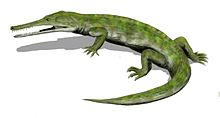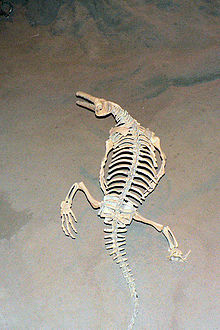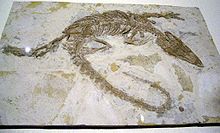- Choristodera
-
Choristoderes
Temporal range: Middle Jurassic - Miocene, 165–20 Ma Possible Late Triassic record
Artist's impression of Champsosaurus Scientific classification 
Kingdom: Animalia Phylum: Chordata Class: Reptilia Node: Romeriida Subclass: Diapsida Order: †Choristodera
Cope, 1884Subgroups Choristodera is an order of semi-aquatic diapsid reptiles which ranged from the Middle Jurassic, or possibly Late Triassic, to at least the early Miocene. Choristoderes have been found in North America, Asia, and Europe. The most common fossils are typically found from the Late Cretaceous to the lower Eocene. Cladists have placed them between basal diapsids and basal archosauromorphs but the phylogenetic position of Choristodera is still uncertain. It has also been proposed that they represent basal lepidosauromorphs. Most recently, workers have placed Choristodera within Archosauromorpha.
Contents
Description and phylogeny
Champsosauridae is the best-known family of the Choristodera and typifies the group. Champsosaurus was first described from Late Cretaceous strata of Montana by Cope in 1876. Champsosaurs resembled modern gharials (gavials) or false gharials. The skull of these animals have a long, thin snout filled with small, sharp conical teeth. This is due to champsosaurs and gharials occupying similar niches: hunting small aquatic prey in rivers and swamps. This is a classic example of evolutionary relay. More primitive choristoderes have shorter, broader snouts.
There are major differences to the gharials and other crocodilians, however, particularly in the skull. The orbits are found well forward on the skull, and the rear of the skull is bulbous, hugely expanded and consists of complex bony arches surrounding empty space. These spaces probably contained massive jaw muscles. Other hypotheses for the spaces, such as an otic sensory organ housing, have been tossed around with little support. The external nares are found on the tip of the rostrum. This indicates that champsosaurs breathed while submerged by extending their rostrum through the water surface while their body rested on the bed of the lake or stream. Crocodylians and phytosaurs have their nares located dorsally on their rostrum or skull respectively. This position allows them to rest submerged just below the surface.
Champsosaur skulls are actually very similar to lizard skulls, though heavily modified. This has led some researchers to consider champsosaurids as lepidosauromorphs. However, champsosaurs lack the complex quadrate of lepidosaurians. With features of both diapsid groups, the phylogenetic position of Choristodera is highly confused.
Other features found in choristoderes include heavily ossified gastralia and modified distal limbs, not just the manus and pes, used as paddles. In addition, champsosaur ribs are short and massive, as in other aquatic reptiles. The thorax is dorso-ventrally flattened, and the tail is laterally compressed to aid in swimming. Skin impressions found with champsosaur fossils show non-overlapping scales of very small size and the skin containing no scutes like those found in crocodilians (see crocodile exoskeleton).
Classification
(after Mikko's Phylogeny Archive,[1] ranks per The Paleobiology Database[2]; all names in italics are genera)
order Choristodera ?Irenosaurus
?Khurendukhosaurus
unnamed Cteniogenys/family Cteniogenidae
unnamed family Hyphalosauridae family Monjurosuchidae Philydrosaurus
suborder Neochoristodera family Champsosauridae Eotomistoma
family Simoedosauridae Liaoxisaurus[3]
Tchoiria
unnamed Ikechosaurus
Fossil record
Long considered to be a morphologically conservative group, recent phylogenetic analyses and descriptions of new taxa have revolutionized understanding of this taxon.
The order Choristodera comprises two monophyletic groups and three basal taxa. Primitive choristoderes are characterized by small body size, a large, dorsally directed orbit and closed lower temporal fenestrae.
Lazarussuchus is the most basal choristodere. It creates a ghost lineage of about 11 million years from the last champsosaur. Cladistic analyses indicate Lazarussuchus is more primitive than Pachystropheus, the possible Triassic choristoderian. Therefore if the cladistic analyses are correct, Lazarussuchus implies a ghost lineage extending back from the Oligocene to the Cretaceous at the very least. This taxon is known from France and the Czech Republic. One species, L. dvoraki, persisted into the early Miocene in the Czech Republic.[4]
Cteniogenys is another basal choristodere. Like Monjurosuchus, it is a small bodied, lizard like animal. The webbed feet of Monjurosuchus reflect its aquatic lifestyle. The former is known from North America and Europe, while the latter is known from China.
The two small-bodied choristoderes, Shokawa and Hyphalosaurus form the clade Hyphalosauridae within Choristodera. Their elongate necks and tails represent a unique shared derived condition. They resemble small plesiosaurs or nothosaurs. Shokawa is known from Japan, and Hyphalosaurus is known from China.
The named clade Neochoristodera includes Champsosaurus, Tchoiria, Simoedosaurus, Ikechosaurus and possibly Pachystropheus. This group of large-bodied reptiles is characterized by elongate snouts and relatively small orbits. Although it reflects our early understanding of the Choristodera as a whole, it in fact represents a highly derived condition.
The neochoristoderan taxa Champsosauridae and Simoedosauridae are found from the Late Cretaceous to the middle Eocene, indicating that the group survived the Cretaceous–Tertiary extinction event. Champsosaurus teeth, vertebrae, and other bones are common fossils in Cretaceous deposits such as the Dinosaur Park Formation of Alberta and the Lance Formation of Wyoming. The presence of champsosaurs as far north as the North Slope of Alaska implies warmer temperatures during the Cretaceous. The Paleocene species, Champsosaurus gigas, is the largest known champsosaur. The most complete skeleton was found at the Wannagan Creek site in North Dakota, but is found throughout North American Paleocene strata in the Dakotas, Wyoming, and Montana. C. gigas is unusual among Paleocene reptiles in that it is far larger than known Mesozoic ancestors, at about 3 meters in length (10 ft) versus 1.5 meters (5 ft) for the largest Cretaceous champsosaurs.
Simoedosaurus is known from Europe and North America, Tchoria is known from Mongolia and Ikechosaurus is known from China. Champsosaurus is known from North America, where its distinctive, hourglass-shaped vertebral centra are important biostratigraphic indicators.
Pachystropheus rhaeticus may or may not be a neochoristodere. If belongs to that taxon, it extends the fossil record of the choristoderes from the Middle Jurassic back 45 mya and implies a significant ghost lineage. However, Pachystropheus lacks any cranial material, and all of the postcranial adaptations that link it to choristoderes may merely reflect convergent adaptations to an aquatic lifestyle. All unambiguous choristoderes were freshwater animals, while Pachystropheus was recovered from European marine transgressive sequences. Pachystropheus may be a choristodere, or it may be a type of thallatosaur, a large bodied, long necked group of marine reptiles. More complete fossil material is needed in order to resolve the placement of Pachystropheus.
The ultimate extinction of choristoderes may have been due to a number of possible causes: falling temperatures in the Oligocene, increased competition from crocodilians, habitat loss, or some combination of these factors.
In 2006, the UK Royal Society announced that it had discovered a two-headed fossil of a choristodere, the first recorded time that such a reptile has been found fossilized. The chances of finding such a fossil are extremely low, as is shown by the current proportion of reptiles born with two heads.
Notes
- ^ Haaramo, Mikko (12 November 2006). "†Choristodera". Mikko's Phylogeny Archive. http://www.helsinki.fi/~mhaaramo/metazoa/deuterostoma/chordata/reptilia/choristodera.html. Retrieved 16 March 2008. (date is for last update to contents)
- ^ "The Paleobiology Database". The Paleobiology Database. http://paleodb.org/cgi-bin/bridge.pl?action=checkTaxonInfo&taxon_no=37784. Retrieved 16 March 2008.
- ^ Gao Chunling; Lu Junchang; Liu Jinyuan; and Ji Qiang (2005). "New choristodera from the Lower Cretaceous Jiufotang Formation in Chaoyang area, Liaoning China" (in Chinese). Geological Review 51 (6): 694–697.
- ^ Evans, Susan E.; and Klembara, Jozef (2005). "A choristoderan reptile (Reptilia: Diapsida) from the Lower Miocene of northwest Bohemia (Czech Republic)". Journal of Vertebrate Paleontology 25 (1): 171–184. doi:10.1671/0272-4634(2005)025[0171:ACRRDF]2.0.CO;2. ISSN 0272-4634.
References
- deBraga, M & O Rieppel (1997), "Reptile phylogeny and the interrelationships of turtles". Zoology. J. Linnean Soc, 120: 281–354
- Erickson, B. R. (1972). "The Lepidosaurian Reptile Champsosaurus in North America". Science Museum of Minnesota, Volume 1: Paleontology, Monograph.
- Evans, SE, and MK Hecht. 1993, A history of an extinct reptilian clade, the Choristodera: Longevity, Lazarus taxa, and the fossil record. Evolutionary Biology, 27:323–338
- Gao, K & RC Fox (1998), "New choristoderes (Reptilia: Diapsida) from the Upper Cretaceous and Palaeocene, Alberta and Saskatchewan, Canada, and phylogenetic relationships of Choristodera". Zoology. J. Linnean Soc, 124: 303–353.
- Gao, K-Q. and D.T. Ksepka. 2008. Osteology and taxonomic revision of Hyphalosaurus (Diapsida: Choristodera) from the Lower Cretaceous of Liaoning, China. Journal of Anatomy 212: 747–760.
- Matsumoto R, Suzuki S, Tsogtbaatar K, Evans SE. 2009. New material of the enigmatic reptile Khurendukhosaurus (Diapsida: Choristodera) from Mongolia. Naturwissenschaften 96 (2): 233–242
- Ksepka D, K Gao and MA Norell. (2005), "A new choristodere from the Cretaceous of Mongolia." American Museum Novitates 3468: 1–22.
- Storrs G.W. & D.J. Gower (1993), 'The earliest possible choristodere (Diapsida) and gaps in the fossil record of semi-aquatic reptiles', Journal of the Geological Society, GSA, 150: 1103–1107
External links
- Palæos Choristodera page
- Mikko's Phylogeny Archive CHORISTODERA-champsosaurs
- UC Berkely Archosauria: Systematics
- BBC News Two-Headed Reptile Fossil Found
- Choristodere research at NCSU
- Ghost lineages—brief article on the fossil record of choristoderes
Archosauromorphs Primitive
ArchosauromorphsPrimitive
ArchosauriformsCrurotarsi Archosaurs Avemetatarsalia and
Ornithodira ArchosaursAvian Archosaurs Avialae • Archaeopteryx • Confuciusornis • Ichthyornis • Enantiornithes • Hesperornithes • Neornithes • Palaeognathae • NeognathaeCategories:
Wikimedia Foundation. 2010.



